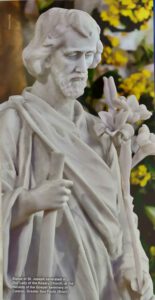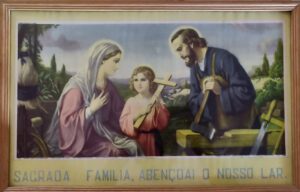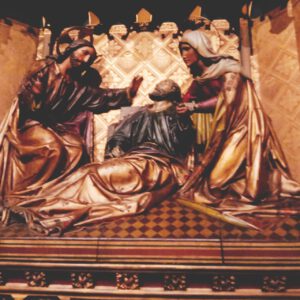
Those three adjectives popped into my head as I spent 1 May pondering the life of the foster father of Jesus. And come to think of it, what do we really know about him? Except for some passages in Matthew and Luke, even the Scriptures have scanty information on his life journey.
Trust and wisdom
Joseph, who was a descendant of the house of King David, exhibited no trappings of royalty. He was only betrothed to Mary, a virgin, when, mysteriously, he found her pregnant. He graciously refrained from condemning her; as “a righteous man and unwilling to expose her to public disgrace” (Mt 1:19), he’d thought of discreetly divorcing her. But this would surely have left the maiden defenceless against a bigoted Jewish society – or so it dawned on him after an angel revealed him God’s magnificent designs. Trusting the divine messenger, he promptly took Mary as his wife. Thus, the role of Joseph who was blessed with expectant faith and total trust would soon prove to be crucial in the history of salvation.
What was Joseph like, as a husband and father, professional and citizen? One thing is for sure – he wasn’t a loudmouth; quietness was his watchword. Soon after Jesus’ birth, he quietly fled with the family to Egypt, escaping carnage of infants at the hands of king Herod of Judea. They returned only after the ruler’s death and settled in Nazareth, far from the glare of the capital city, Jerusalem. He worked as a modest carpenter, and was helped by his divine son. A dutiful citizen that he was, he’d earlier made a trip to his city, Bethlehem, to enrol the couple in the census. Finally, Joseph was a devoted father too; he joined Mary in searching for their son lost in Jerusalem. But then, quite perplexingly, even here we don’t get to hear his voice.

Pope Benedict XVI has stated that Joseph led a “simple and industrious life, cultivating the conjugal relationship with care and fulfilled with enthusiasm the great and difficult educational mission.” (Angelus, St Peter’s Square, 19 March 2006) Yet, in modern parlance, we tend to dismiss such a man as lacking l’esprit. So, could it be that Joseph’s portrayal as an old and unattractive man induced the silence that we’ve weaved around him down the centuries? Some believe that his elderly mien is meant to account for his wisdom fit for the father of Jesus. And hopefully, showing him as past his prime would help explain how he abstained from conjugal relations with a young and pretty wife.
While the Pope Emeritus makes ample references to how Joseph treated Mary with love and care, Fulton Sheen, portrays the Saint more dramatically, in The World’s First Love. He profiles him as “probably a young man, strong, virile, athletic, handsome, chaste, and disciplined, the kind of man one sees… working at a carpenter’s bench.” Although society then was probably less conscious of physical attributes than we are today, those are some that would rightly distinguish the holy family of Nazareth. And practically speaking, how else would a man provide for a family of three?
The insightful Archbishop has a take on Joseph’s libido as well: “Instead of being a man incapable of loving, he must have been on fire with love.” But, then, as a counterpoint he sheds light on how “young girls in those days, like Mary, took vows to love God uniquely, and so did young men, of whom Joseph was one so preeminent as to be called the ‘just’. Instead, then, of being dried fruit to be served on the table of the King, he was rather a blossom filled with promise and power. He was not in the evening of life, but in its morning, bubbling over with energy, strength, and controlled passion.”

That’s how Joseph must have lived the elevated life that God had called him for. The circumstances of his death are unknown, but it is surmised that he died before Jesus’ public life began, if not, certainly before the Crucifixion (Jn 19: 26-27). We could reason out that God thus saved him the anxiety of seeing Jesus vilified in his public ministry: really, how would a father – an honourable man – take it lying down? It might have well compelled him to come out into the open and defend his son. But if this conjecture be false, God for sure saved him from the cruelty of witnessing the humiliating death of his Son on the Cross.
Honouring Joseph
Be that as it may, Joseph was an unsuspecting man, for he trusted in the Lord; he was silent, as he knew how to take it all in his stride. So now the moot question is: why do we forget him so very easily?
Curiously, veneration of Joseph began in his land of self-exile, Egypt, and the same took about thirteen centuries to take root in the West. This finally happened when the Servites, an order of mendicant friars, began to observe his feast on 19 March, the traditional day of his death.
Later promoters of the devotion included Pope Sixtus IV, who introduced the feast circa 1479, and the celebrated sixteenth-century mystic St Teresa of Avila, who attributed her miraculous cure of paralysis to him. After Mexico, Canada, and Belgium declared Joseph their patron, Pope Pius IX in 1870 declared him patron of the Universal Church. In 1955, Pope Pius XII established the Feast of St Joseph the Worker on 1 May as a counter-celebration to the communist-sponsored May Day.
A feast day, however, should rise above tokenism. We must therefore have recourse to this admirable saint – emblematic of the world’s forgotten fathers – in the ups-and-downs of our daily life. No artist or writer has captured the essence of the man as beautifully as the litany in his honour has: “St. Joseph – chaste guardian of the Virgin, foster father of the Son of God, diligent protector of Christ, head of the Holy Family, most just, most chaste, most prudent, most strong, most obedient, most faithful.”

Closer to our times, Pope Benedict XVI highlighted a much neglected aspect of Joseph’s life – chastity – by introducing the reference in the Eucharistic prayer, after Mary: “St Joseph, her Most Chaste Spouse”. (Why many celebrants avoid the operative word is anybody’s guess) The Pope revealed that his predecessor, John Paul II, who was devoted to St Joseph, and dedicated to him the Apostolic Exhortation Redemptoris Custos (Guardian of the Redeemer), experienced his assistance at the hour of death.
In an era when fatherhood is relegated to the background even in birth certificates; masculinity is equated with machismo; and chastity disdained in the age of the sexual revolution, we are invited to emulate the counterexample of St Joseph.
In particular, on 1 May, let us make Pope Pius X’s Prayer to the Model of Workers our own, so that our labour and toil may draw abundant fruit in this valley of tears, particularly given the rapid and complex changes due to happen in the covid and post-covid eras.
(To the memory of my parents Fernando de Noronha and Judite da Veiga, on their 56th wedding anniversary)
Credits:
Pic 1 – Statue at Our Lady of the Rosary Church, Heralds of the Gospel Seminary, Caeiras, Greater São Paulo, Brazil. Taken from the magazine of the Heralds of the Gospel (Vol. V, No. 43, May 2011)
Pic 2 – Frame that my parents made it a point to gift to each of their five sons at their marriage.
Pic 3 – Death of St Joseph: panel of the Church of Our Lady (Onze Lieve Vrouwekerk, Amsterdam). Information provided by my friend Caetano Filipe Colaço (Margão/Dona Paula)
Pic 4 – Prayer to St Joseph, Model of Workers, composed by St Pius X. Source: magazine of the Heralds of the Gospel (as above)
(Also published in The Examiner, December 2021)
Beautiful account and article Oscar! Enjoyed reading it.
An excellent article on St. Joseph.
There’s a book in Konkani named Bhagivont Josechea Devosnache Pustok. Superb book. Please read it. Would be nice if it was translated to English for English-speaking people.
Beautiful. Read thoroughly being an ardent devotee of this Greatest Male Saint